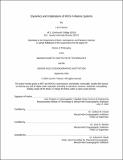Dynamics and Implications of ROS in Marine Systems
Author(s)
Taenzer, Lina
DownloadThesis PDF (5.044Mb)
Advisor
Hansel, Colleen M.
Wankel, Scott D.
Terms of use
Metadata
Show full item recordAbstract
The reactive oxygen species (ROS), superoxide and hydrogen peroxide, play critical roles across diverse marine ecosystems, influencing redox chemistry and organismal health. The distribution and concentration of these compounds in the oceans may serve as important controls for various biogeochemical cycles. The contrasting physiological nature of ROS, serving as both integral compounds for cellular processes such as signaling and growth while inducing oxidative cell damage at elevated concentrations, has made interpretation of their roles in organismal and ecosystem health challenging. Despite the potential for these ROS to provide unique insights into the intricate interactions occurring at the interface between life and its surrounding environment, critical gaps in our understanding of these compounds in marine systems exist. In this thesis I explored two aspects of marine ROS. The first part is focused on advancing our understanding of the distribution of superoxide in the sea. As part of a multidisciplinary team, I developed a submersible chemiluminescent sensor (SOLARIS) capable of measuring ROS in situ to ocean depths greater than 4,000 meters. With the use of SOLARIS, I discovered that a broad diversity of sponges and corals are local hotspots of superoxide at depth. Then, I studied the distribution of superoxide in the stratified water column of the Baltic Sea and found large subsurface maxima in the aphotic zone. In the second part of this thesis, I probed the use of hydrogen peroxide as a monitoring agent of organismal health. I measured hydrogen peroxide and bromoform production by two seaweed species exposed to different stressors. An analysis of these signals suggests that hydrogen peroxide could serve as a non-invasive chemical signature for stress in seaweed meadows and farms. Lastly, I characterized hydrogen peroxide associated with different coral species during a Stony Coral Tissue Loss Disease transmission experiment. I determined that hydrogen peroxide does not predict infection before lesions are visible, thus hindering its utility as an early-stage signature of disease within corals. Altogether, this thesis extends our perspective on the distribution and controls on ROS in various marine systems and provides a baseline for using ROS dynamics to monitor organismal health.
Date issued
2024-09Department
Massachusetts Institute of Technology. Department of Earth, Atmospheric, and Planetary SciencesPublisher
Massachusetts Institute of Technology